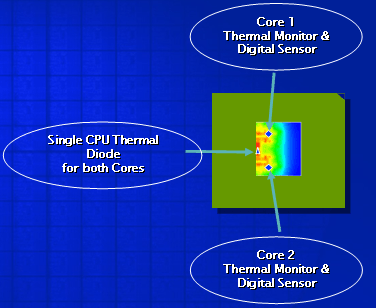Will Core Duo Notebooks Trade Battery Life For Quicker Response?
Digital Media Boost
Intel uses the name "Digital Media Boost" to refer to a variety of new features, including the addition of the SSE3 instruction and accommodations for larger floating point numbers. According to Intel, these capabilities should speed up the playback and rendering of digital content, and thus lead to a better multimedia experience on suitably-equipped PCs.
| CPU | Instructions |
|---|---|
| Intel Core Duo | MMX, SSE, SSE2, SSE3 |
| Intel Dothan | MMX, SSE, SSE2 |
| AMD Turion 64 | MMX, 3DNow!, SEE, SSE2, SSE3, x86-64 |
Intel Advanced Thermal Management
Compared to its predecessors, thermal monitoring and management for Core Duo processors has been refined.
Every working subsystem inside the Core Duo processor has its own thermal monitor and a temperature sensor near all known hot spots. The legacy thermal diode - which is intended to prevent a CPU from self-destructing should the die overheat too much as a result of a failed or defective CPU fan - is shared between both cores. Because each core makes a separate temperature sensor available, it is theoretically possible to regulate the speed of the CPU fan more precisely; this is due to the paramount importance of die temperature in regulating the cooling system. As a consequence, Yonah notebooks should run more quietly and last longer.
Get Tom's Hardware's best news and in-depth reviews, straight to your inbox.
Current page: Digital Media Boost
Prev Page Dynamic Power Coordination, Continued Next Page I've Got A Core Duo Processor LV L2400. What Have You Got?